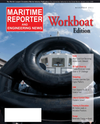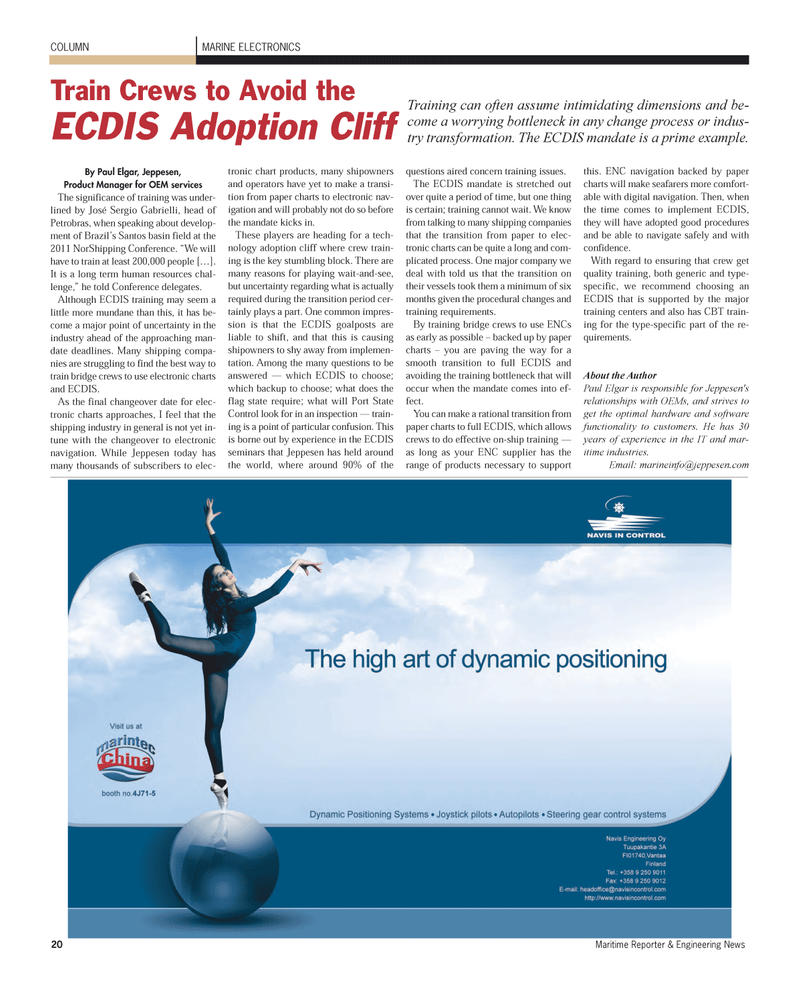
Page 20: of Maritime Reporter Magazine (November 2011)
Feature: Workboat Annual
Read this page in Pdf, Flash or Html5 edition of November 2011 Maritime Reporter Magazine
MARINE ELECTRONICSCOLUMNBy Paul Elgar, Jeppesen, Product Manager for OEM services The significance of training was under- lined by José Sergio Gabrielli, head of Petrobras, when speaking about develop- ment of Brazil?s Santos basin field at the 2011 NorShipping Conference. ?We will have to train at least 200,000 people [?]. It is a long term human resources chal-lenge,? he told Conference delegates. Although ECDIS training may seem alittle more mundane than this, it has be-come a major point of uncertainty in theindustry ahead of the approaching man-date deadlines. Many shipping compa- nies are struggling to find the best way to train bridge crews to use electronic charts and ECDIS.As the final changeover date for elec- tronic charts approaches, I feel that theshipping industry in general is not yet in-tune with the changeover to electronic navigation. While Jeppesen today has many thousands of subscribers to elec- tronic chart products, many shipowners and operators have yet to make a transi- tion from paper charts to electronic nav- igation and will probably not do so before the mandate kicks in.These players are heading for a tech-nology adoption cliff where crew train- ing is the key stumbling block. There are many reasons for playing wait-and-see, but uncertainty regarding what is actually required during the transition period cer- tainly plays a part. One common impres-sion is that the ECDIS goalposts areliable to shift, and that this is causingshipowners to shy away from implemen- tation. Among the many questions to be answered ? which ECDIS to choose;which backup to choose; what does theflag state require; what will Port StateControl look for in an inspection ? train-ing is a point of particular confusion. This is borne out by experience in the ECDIS seminars that Jeppesen has held aroundthe world, where around 90% of the questions aired concern training issues.The ECDIS mandate is stretched outover quite a period of time, but one thing is certain; training cannot wait. We know from talking to many shipping companies that the transition from paper to elec-tronic charts can be quite a long and com-plicated process. One major company we deal with told us that the transition ontheir vessels took them a minimum of six months given the procedural changes and training requirements.By training bridge crews to use ENCs as early as possible ? backed up by paper charts ? you are paving the way for a smooth transition to full ECDIS andavoiding the training bottleneck that will occur when the mandate comes into ef-fect.You can make a rational transition from paper charts to full ECDIS, which allows crews to do effective on-ship training ? as long as your ENC supplier has therange of products necessary to supportthis. ENC navigation backed by paper charts will make seafarers more comfort- able with digital navigation. Then, when the time comes to implement ECDIS,they will have adopted good procedures and be able to navigate safely and with confidence. With regard to ensuring that crew get quality training, both generic and type-specific, we recommend choosing an ECDIS that is supported by the majortraining centers and also has CBT train-ing for the type-specific part of the re- quirements.About the Author Paul Elgar is responsible for Jeppesen's relationships with OEMs, and strives to get the optimal hardware and software functionality to customers. He has 30 years of experience in the IT and mar- itime industries. Email: [email protected] Crews to Avoid the ECDIS Adoption Cliff Training can often assume intimidating dimensions and be- come a worrying bottleneck in any change process or indus- try transformation. The ECDIS mandate is a prime example. 20Maritime Reporter & Engineering News MR Nov.11 # 3 (18-24):MR Template 11/4/2011 2:36 PM Page 20

 19
19

 21
21
